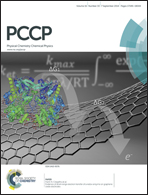Lead-iodide nanowire perovskite with methylviologen showing interfacial charge-transfer absorption: a DFT analysis
Abstract
Methylviologen lead-iodide perovskite (MVPb2I6) is a self-assembled one-dimensional (1-D) material consisting of lead-iodide nanowires and intervening organic electron-accepting molecules, methylviologen (MV2+). MVPb2I6 characteristically shows optical interfacial charge-transfer (ICT) transitions from the lead-iodide nanowire to MV2+ in the visible region and unique ambipolar photoconductivity, in which electrons are transported through the three-dimensional (3-D) organic network and holes along the 1-D lead-iodide nanowire. In this work, we theoretically study the electronic band-structure and photocarrier properties of MVPb2I6 by density functional theory (DFT) calculations. Our results clearly confirm the experimentally reported type-II band alignment, whose valence band mainly consists of 5p (I) orbitals of the lead-iodide nanowires and the conduction band of the lowest unoccupied molecular orbital of MV2+. The DFT calculation also reveals weak charge-transfer interactions between the lead-iodide nanowires and MV2+. In addition, the electronic distributions of the valence and conduction bands indicate the 3-D transport of electrons and 1-D transport of holes, supporting the reported experimental result.


 Please wait while we load your content...
Please wait while we load your content...